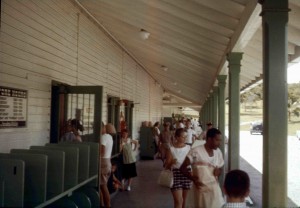Behind the Cactus Curtain: Innocence in the Midst of History-Making
National Dialogue and Traveling Exhibit
Hearing Susan Lagos reminisce about her childhood of horseback riding, traveling with her parents, learning Spanish, and memorizing Shakespeare for high school English, you would think she was a fairly normal middle-class American who grew up in the 1950s and 1960s. But Susan did not grow up in America; she grew up as a civilian’s daughter on the U.S. Naval Base at Guantanamo Bay, Cuba. She rode her horse around the base, she traveled with her parents inside Cuba before the Revolution of 1959, she learned Spanish from communicating with her Cuban friends and neighbors, and she still today is upset that she never took her Shakespeare test in October 1961 because that day GTMO was evacuated due to the Cuban Missile Crisis.
Amazingly it seems that at one time in its long history of imperialism, paternalism, anti-communism and violence, GTMO was a picture of Small Town U.S.A.; a “Mayberry” intimately surrounded by Cold War threats and social tensions, yet protected by innocence. In the same way, behind the picturesque images of 1950s America hides anti-communist McCarthyism, the creation of the Military Industrial Complex, the Civil Rights Movement, and the emergence of Rock ‘n’ Roll. It seems to me that within those forty-some acres of GTMO, all of the political, economic, cultural and social issues of the 1950s and 1960s can be seen.
Behind fond memories of exploring this exotic paradise, memories of social inequality and revolution linger for the men and women who share a history with the base. In the interview I recorded with her in September 2012, Susan Lagos recalls that maids on the base would sneak soap out past the base guards in pill boxes. Janet Miller, in her memoir, describes breaking many base rules in order to help her Cuban friends send letters, money, and personal items to their family in America. Racial tensions of the 1950s and 1960s were apparent at GTMO, but in a different way than in the U.S. At GTMO, differences between black and white became less of a focus than between Cuban and American. The segregation already apparent in Cuban society (a legacy of colonization), mixed well with American segregation. Cubans were the ones serving as maids in American houses and as gardeners on a base that was on their soil. Children were taught Spanish in school, but how many Americans put effort into communicating with the Cuban people? How many Americans really took the time to pay attention to the policies and problems going on across the cactus curtain?
From the accounts of Susan Lagos and Janet Miller, it seems that ignorance of the world around them was the rule, not the exception, for most Americans on the base. This disjunction between the world on the base and the outside world is surprising to us in hindsight, privileged as we are with knowing the historical events surrounding Cuba. But this ignorance, this isolation is just a part of CTMO history. It seems that events surrounding the base play a larger part in defining its history than the events actually happening within it.
Submitted by Alexandra Latona- M.A. Candidate University of North Carolina Greensboro
University of North Carolina Greensboro is participating in the Guantánamo Public Memory Project‘s National Dialogue and Traveling Exhibit. Opening at NYU’s Kimmel Center for University Life Windows Gallery in December 2012 and traveling to 9 sites (and counting) across the country through at least 2014, the exhibit will explore GTMO’s history from US occupation in 1898 to today’s debates and visions for its future. The exhibit is being developed through a unique collaboration among a growing number of universities as a dialogue among their students, communities, and people with first-hand experience at GTMO.

